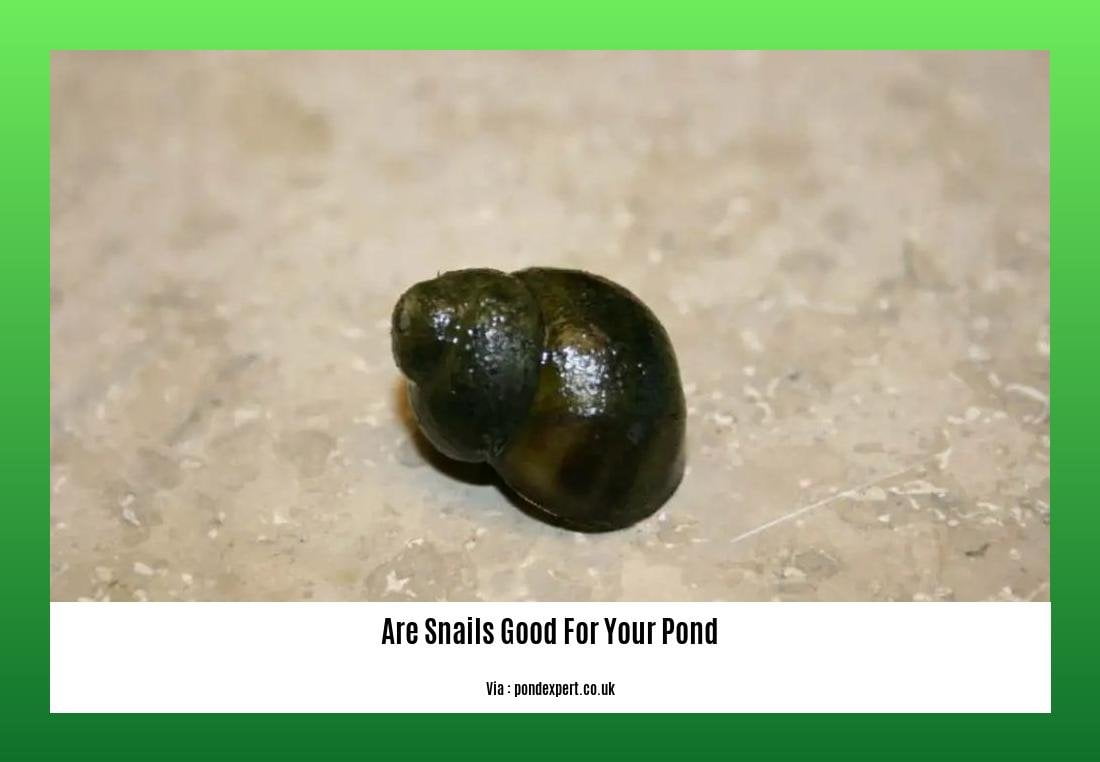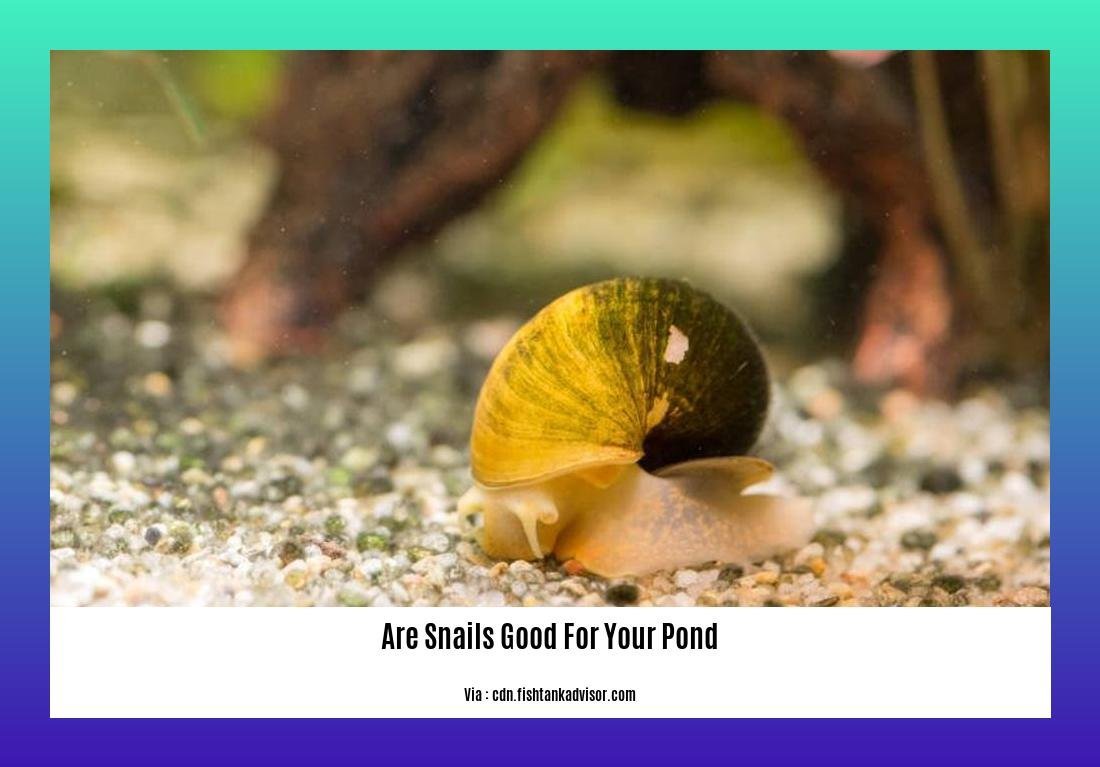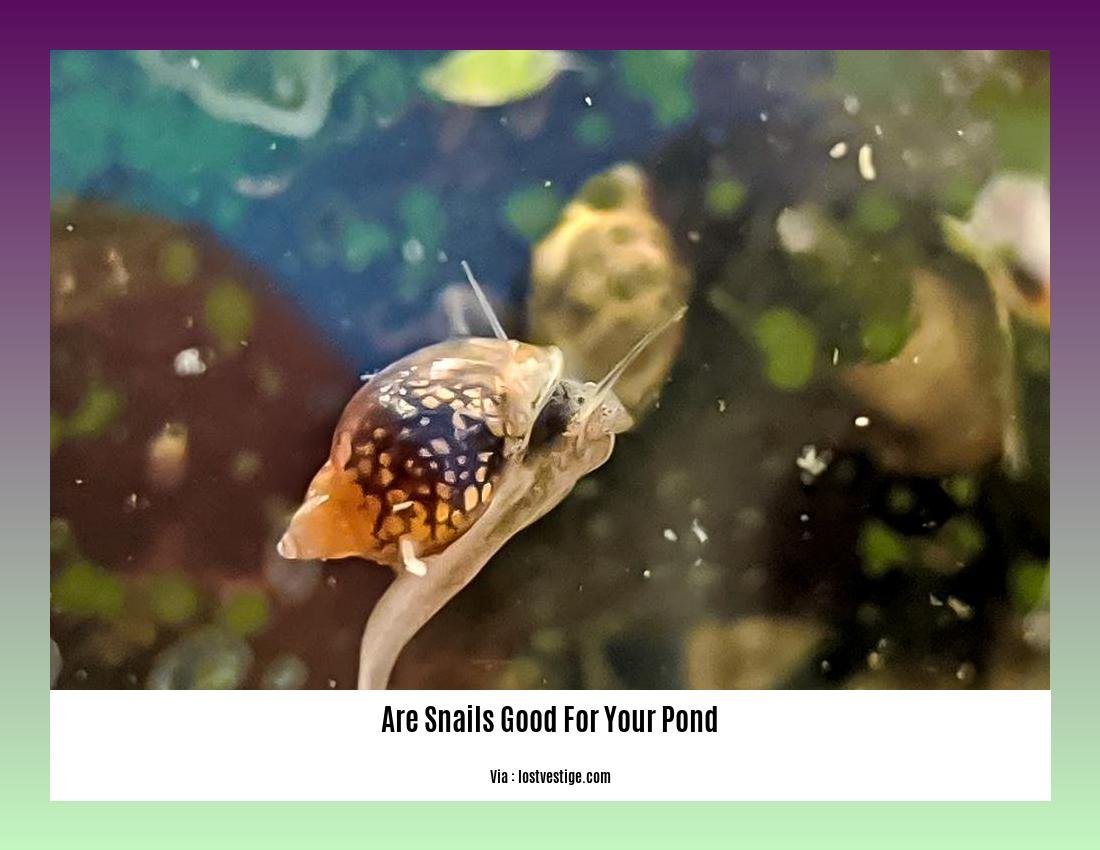Aquatic ecosystems are intricate and fascinating, with numerous organisms playing vital roles in their delicate balance. One such creature that often goes unnoticed but holds significant importance is the snail. In this article, titled “Are Snails Good for Your Pond? Exploring the Beneficial Role of Snails in Aquatic Ecosystems,” we delve into the various benefits of having snails in ponds and how they contribute to a thriving and sustainable environment. From maintaining water quality to controlling algae growth and serving as a natural food source for fish, these often-underestimated creatures have much to offer. Let’s explore the fascinating world of snails and their positive impact on pond ecosystems.
Key Takeaways:
- Pond snails contribute to a thriving pond ecosystem by grazing on algae, aiding in nutrient cycling, acting as natural janitors, and aiding in filtration.
- Snails help keep the pond clean by feeding on algae and detritus, which releases nitrogen from sediment.
- They also help with filtration by turning sediments.
- Some people use snails as decorative animals for their ponds.
Are Snails Good for Your Pond?

When it comes to maintaining a healthy and thriving pond ecosystem, one often-underestimated creature can make a big difference: snails. These little mollusks may not be the first thing that comes to mind when you think about pond life, but they actually play a crucial role in keeping your pond clean and balanced. In this article, we will explore the beneficial role of snails in aquatic ecosystems and why they are indeed good for your pond.
The Grazing Guardians of Algae
One of the main benefits of having snails in your pond is their ability to graze on algae. Algae is a common problem in many ponds, and excessive growth can lead to poor water quality and unsightly green water. However, snails are natural control agents when it comes to algae. They feed on the algae, helping to keep its population in check and preventing excessive growth. By consuming algae, snails contribute to clearer water and a more aesthetically pleasing pond environment.
Natural Janitors and Nutrient Cyclers
Snails in your pond are not just algae-eating machines; they also act as natural janitors. They feed on detritus, which includes dead plant matter, decaying leaves, and other organic debris that accumulate in the pond. By consuming detritus, snails help to break it down into smaller particles, aiding in nutrient cycling. This process releases nitrogen, an essential nutrient for plants, from the sediment and makes it available for other organisms in the pond.
Filtration Fanatics
Another important role of snails in your pond is their ability to turn sediments and aid in filtration. As snails move through the sediment, they disturb it, helping to prevent the buildup of organic matter and debris. This disturbance increases the water’s circulation and oxygenation, promoting a healthier pond ecosystem. Additionally, the movement of snails helps to prevent the sediment from becoming compacted, which can hinder the growth of beneficial bacteria and create anoxic conditions.
Decorative Delights
Beyond their functional benefits, snails can also add a decorative touch to your pond. With their unique shells and slow, graceful movements, snails can be fascinating creatures to observe. They can enhance the aesthetic appeal of your pond and bring a sense of tranquility to your outdoor space. Some varieties of snails, such as trapdoor snails, are especially popular for their decorative qualities and ability to blend seamlessly into the pond environment.
In conclusion, snails are indeed good for your pond. These small but mighty creatures contribute to the overall health and balance of the aquatic ecosystem. They help control algae growth, act as natural janitors by consuming detritus, aid in nutrient cycling, promote filtration through sediment disturbance, and add a decorative element to your pond. By incorporating snails into your pond, you can create a thriving and sustainable aquatic environment for both plants and animals. So, embrace the snails and enjoy the benefits they bring to your pond.
Sources:
1. Pond Informer: Are Snails Good or Bad for Garden Ponds?
2. Pest Pointers: 6 Reasons Why Trapdoor Snails Are Good for Ponds
Are snails poisonous to dogs in Australia? Find out more about the potential dangers at this link.
Curious about whether trapdoor snails are beneficial for your pond? Discover the answer here and learn how they can enhance your pond’s ecosystem.
Worried about having turtles in your pond? Click here to explore whether they are actually harmful and how they may affect your pond’s balance.
Did you know that garden snails can be beneficial? Discover their surprising advantages here and learn how they can positively impact your garden’s health.
Do Pond Snails Eat Algae & Plants?

Pond snails may seem like insignificant creatures, but they actually play a vital role in maintaining the health and balance of aquatic ecosystems. One of the most common questions regarding pond snails is whether they eat algae and plants. The answer is yes, pond snails do consume algae and certain plants, but it’s important to understand the specifics of their diet to ensure the safety of your pond’s vegetation.
What Do Pond Snails Eat?
Pond snails are omnivorous, meaning they have a varied diet that includes both plant matter and other organic material. Their primary source of food is algae, which they graze on to control its growth. This helps to prevent excessive algae blooms, which can lead to poor water quality and oxygen depletion. By consuming algae, pond snails contribute to the overall cleanliness and clarity of the water.
In addition to algae, some species of pond snails also feed on certain plants. However, not all plants are on their menu. The specific plant species that pond snails consume can vary depending on the individual snail and the availability of other food sources. It’s important to do your research and identify the species of pond snails present in your pond to ensure that they do not pose a threat to any desired plants.
The Benefits of Pond Snails in Your Pond
The presence of pond snails in your pond can bring about several advantages. By consuming decaying plants, organic matter, and other debris, pond snails assist in the breakdown of organic waste, preventing the accumulation of harmful substances. This reduces the risk of water quality issues and promotes a healthier environment for aquatic life.
Pond snails also help aerate the pond by stirring up sediment as they move through the water. This movement aids in the circulation of oxygen, which is crucial for the survival of fish and other organisms. Additionally, their feeding activity can turn over sediments, contributing to natural filtration processes within the pond.
Considerations and Potential Issues
While pond snails can be beneficial to ponds, there are some important considerations to keep in mind. First, pond snails are prolific breeders and can quickly multiply in numbers. It’s necessary to monitor their population to prevent overpopulation, which could lead to imbalances in the ecosystem.
Moreover, not all species of pond snails are desirable. While some species are effective grazers on algae and beneficial for pond maintenance, others may have a preference for harmful blue-green algae. It’s crucial to identify the species in your pond and be aware of their specific feeding habits to ensure that they are contributing positively to your pond’s ecosystem.
Lastly, pond snails can accidentally be introduced into ponds through various means such as plants or equipment. If you find that they are unwanted in your pond, there are methods available to control and remove them along with their eggs.
Key Takeaways:
- Pond snails consume algae and certain plant material, aiding in the control of algae growth and contributing to water clarity.
- Carefully identify the species of pond snails in your pond to ensure they do not pose a threat to desired plant life.
- Pond snails help break down decaying plants and debris, promoting cleaner water and a healthier environment for aquatic life.
- Their movement through the water helps aerate the pond and contributes to natural filtration processes.
- Monitor pond snail populations to prevent overpopulation and potential imbalances in the ecosystem.
- Not all species of pond snails are desirable, so understanding their specific feeding habits is crucial.
- If unwanted, there are methods available to control and remove pond snails and their eggs.
Sources:
1. Do Pond Snails Eat Plants? (The Answer Is Here!)
2. Are Snails Good or Bad for Garden Ponds? (Pond Snail Facts)
Types Of Pond Snails
Pond snails can be a fascinating addition to your pond ecosystem, providing numerous benefits to the overall health and balance of the aquatic environment. Understanding the different types of pond snails available can help you choose the right ones for your specific needs. Let’s explore some of the most popular types of pond snails and their unique characteristics.
1. Tiger Nerite Snail
The Tiger Nerite Snail (Keyword: Types Of Pond Snails) is known for its striking black and gold patterns on its shell, resembling the stripes of a tiger. This snail species is highly efficient at consuming algae, making it an excellent choice for maintaining water clarity and preventing excessive algae growth in your pond. With their visually appealing shells, these snails also add a touch of natural beauty to your aquatic landscape.
2. Black Devil Snail
The Black Devil Snail (Keyword: Types Of Pond Snails) is a relatively larger snail species that can reach sizes of up to 2 inches. These snails have a dark brown or black shell, often with contrasting patterns or bands. Black Devil Snails are efficient grazers and contribute to organic matter cleanup in your pond. They feed on decaying plant material and detritus, helping to improve water quality and promote a healthier environment for your pond inhabitants.
3. Horned Nerite Snail
The Horned Nerite Snail (Keyword: Types Of Pond Snails) is easily identifiable by the small, horn-like protrusions on its shell. These snails are renowned for their ability to graze on algae and keep it in check. With their eye-catching striped or zigzag-patterned shells, Horned Nerite Snails can also add a touch of visual interest to your pond. They are generally peaceful and can coexist with various fish and other aquatic creatures in your pond.
4. Zebra Nerite Snail
The Zebra Nerite Snail (Keyword: Types Of Pond Snails) is highly sought after for its beautiful shell patterns, resembling the stripes of a zebra. These snails are fantastic algae eaters and can help maintain water clarity in your pond. Zebra Nerite Snails are small in size and can fit into tight spaces, making them effective cleaners in hard-to-reach areas of your pond. They are peaceful and can thrive alongside other pond inhabitants.
5. Japanese Trapdoor Snail
The Japanese Trapdoor Snail (Keyword: Types Of Pond Snails) is an excellent choice for larger ponds with ample vegetation. These snails have a unique operculum, which acts as a trapdoor to protect them from potential predators. Japanese Trapdoor Snails are effective at consuming algae and decaying organic matter, contributing to water quality improvement. Their presence can help create a balanced ecosystem in your pond.
Key Takeaways:
- Tiger Nerite Snails, Black Devil Snails, Horned Nerite Snails, Zebra Nerite Snails, and Japanese Trapdoor Snails are popular types of pond snails.
- Tiger Nerite Snails and Zebra Nerite Snails are known for their efficient algae control and water clarity maintenance.
- Black Devil Snails contribute to organic matter cleanup in ponds.
- Horned Nerite Snails have horn-like protrusions on their shells and are effective grazers of algae.
- Japanese Trapdoor Snails are well-suited for larger ponds with abundant vegetation.
Sources:
FAQ
Q1: What are the benefits of snails in ponds?
A1: Snails in ponds provide benefits such as maintaining water quality, controlling algae growth, and serving as a natural food source for fish. They also aid in nutrient cycling and act as natural janitors to keep the pond clean.
Q2: Are pond snails good for aquariums?
A2: Yes, pond snails can be beneficial for aquariums. They contribute to maintaining water quality by consuming algae and organic matter. However, it is important to manage their population to avoid potential issues with water quality.
Q3: Do pond snails eat algae and plants?
A3: Yes, pond snails eat algae and certain plants. They are known for their ability to control excessive algae growth and help maintain water clarity in ponds and aquariums. However, some species may nibble on pond plants if there is insufficient algae to sustain them.
Q4: What types of pond snails are suitable for freshwater tanks?
A4: Some suitable pond snail species for freshwater tanks include Tiger Nerite Snails, Black Devil Snails, Horned Nerite Snails, Zebra Nerite Snails, and Japanese Trapdoor Snails. These snails not only add visual interest to the tank but also serve as efficient algae eaters.
Q5: How can I control or remove pond snails from my tank?
A5: If you need to control or remove pond snails from your tank, you can try manual removal by hand or with a net. Introducing natural predators or using chemical treatments sparingly may also help control the snail population. However, it is important to consult a professional or experienced aquarist before using any chemicals.












